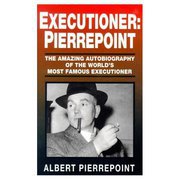
Albert Pierrepoint (30 March 1905 – 10 July 1992) was a long-serving hangman in England. He executed at least 400 people, about half of them war criminals, including William Joyce (one of the men dubbed “Lord Haw-Haw“), and John Amery, whom he considered the bravest man he had ever hanged. Pierrepoint was often dubbed the Official Executioner, despite there being no such job or title. The office of executioner had traditionally been performed by the local sheriff, who increasingly delegated the task to a person of suitable character, employed and paid only when required. Pierrepoint continued to work for years in a grocery near Bradford after qualifying as an Assistant Executioner in 1932 and a Chief Executioner in 1941, in the steps of his father and uncle. Following his retirement in 1956, the Home Office acknowledged Pierrepoint as the most efficient executioner in British history. He subsequently became a publican in Lancashire and wrote his memoirs, in which he sensationally concluded that capital punishment was not a deterrent. There is no official tally of his hangings, which some have estimated at more than 600; the most commonly accepted figure is 435.
Below: Original oil painting of 3 generations of the Pierrepoint family , who were all Britain’s chief executioners … Painted by local Gloucestershire artist Paul Bridgman , on display at Littledean Jail.

ABOVE AND BELOW : VARIOUS HANDWRITTEN AND SIGNED CORRESSPONDENCE FROM HANGMAN AND EXECUTIONER ALBERT PIERREPOINT ON DISPLAY AT THE CRIME THROUGH TIME COLLECTION , LITTLEDEAN JAIL .






 Among the notable people he hanged:
Among the notable people he hanged:
- A total of 202 German war criminals executed between 1945 and 1949, following a series of war trials e.g. the Hamburg Ravensbrück Trials (16 executions between 1947 and 1949) and theStalag Luft III murder trials, which resulted in 13 executions on 27 February 1948. The list of condemned includes Juana Bormann (Auschwitz); Irma Grese, the youngest concentration camp guard to be executed for crimes at Bergen-Belsen concentration camp and Auschwitz (aged 22); and Elisabeth Volkenrath (Bergen-Belsen and Auschwitz); plus another 10 men includingJosef Kramer (Camp Commandant at Belsen) and Fritz Klein. All 13 were condemned at the Belsen Trial and subsequently executed at Hamelin Prison on 13 December 1945 at half-hour intervals. The women were hanged individually, the men in pairs. Executing a large number of war criminals in a single day was not unusual for Pierrepoint. For example, he performed the following 11 executions at Hamelin Prison on 8 October 1946, which resulted from the Neuengamme War Crimes Trial earlier the same year:
- Max Pauly
- SS Dr Bruno Kitt
- Anton Thumann
- Johann Reese
- Willy Warnke
- SS Dr Alfred Trzebinski
- Heinrich Ruge
- Wilhem Bahr
- Andreas Brems
- Wilhelm Dreimann
- Adolf Speck
- “Lord Haw-Haw“, William Joyce, convicted as a traitor and executed at Wandsworth, 3 January 1946.
- Bruno Tesch, co-inventor of the insecticide Zyklon B used in the Holocaust. Convicted of the crime of complicity in the murder of interned allied civilians by means of poison gas by a British military tribunal at the Curiohaus in Rotherbaum, Hamburg. Executed on May 16, 1946 in Hamelin Prison.
- John George Haigh, the “Acid-bath murderer” executed at Wandsworth on 10 August 1949.
- Gordon Cummins, the “Blackout Ripper” executed at Wandsworth on 25 June 1942
- Timothy John Evans, hanged at Pentonville Prison on 9 March 1950 for the murder of his daughter (he was also suspected of having murdered his wife). Timothy Evans received a posthumous pardon in 1966 for the murder of his daughter. It was subsequently discovered that Evans’ neighbour, John Reginald Christie, was a serial killer. He was executed by Pierrepoint on 15 July 1953 at Pentonville.
- James Inglis, on 8 May 1951, the fastest hanging on record – a total of seven seconds elapsed from the time that Inglis left the Condemned Cell.
- Derek Bentley, executed at Wandsworth on 28 January 1953 for his part in the death of Police Constable Miles. The execution was carried out despite pleas for clemency by large numbers of people, including 200 Members of Parliament, the widow of Miles, and the jury’s recommendation in the trial. An article written by Pierrepoint for The Guardian, but withheld until the pardon was granted, dispelled the myth that Bentley had cried on his way to the scaffold. Right until the last, he believed he would be reprieved. After a 45-year-long campaign, Bentley received a posthumous pardon in July 1998, when the Court of Appeal ruled that Bentley’s conviction was “unsafe” and quashed it.
- Michael Manning, on 20 April 1954 the last person to be executed in the Republic of Ireland.
- John Amery, son of wartime Secretary of State for India, Leopold Amery, and the first person to plead guilty to treason in an English court since Summerset Fox in May 1654. He was described by Pierrepoint as “the bravest man I ever hanged”. According to the official prison record of the execution, later released and now stored in the National Archives, Amery greeted his executioner with the words “Oh! Pierrepoint”, but the executioner took the proffered hand only to put the pinioning strap on, making no reply. However, this account is disputed, as Pierrepoint himself later stated in interview that the two men spoke at length and he felt that he had known Amery “all his life”, and there is a story that Amery greeted Pierrepoint with, “Mr. Pierrepoint, I’ve always wanted to meet you. Though not, of course, under these circumstances!” Hanged at Wandsworth Prison, London, 19 December 1945.
- Ruth Ellis, the last woman to be hanged in Britain, on 13 July 1955, for shooting her lover. Pierrepoint had no regrets about her execution; it was one of the few times he spoke publicly about one of his charges and he made it clear he felt she deserved no less.

